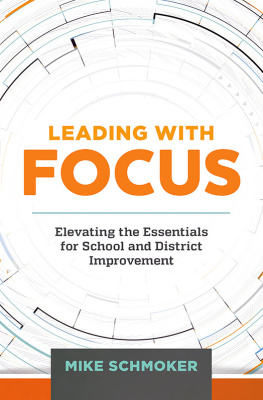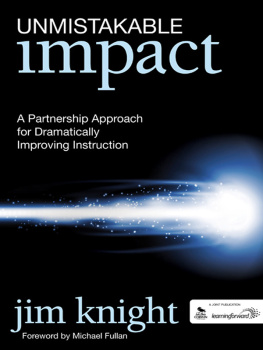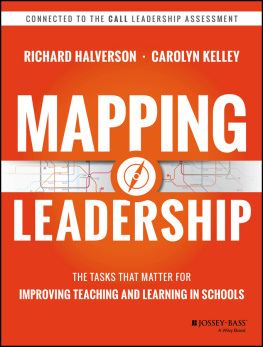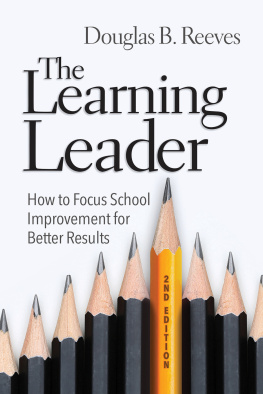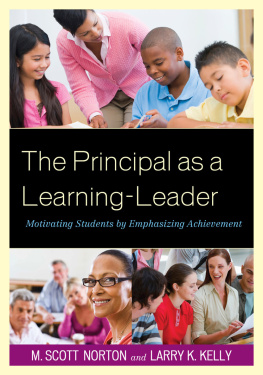Acknowledgments
....................
This book could not have been written without the help of the successful leaders whose work is at the core of what I advocate in this book. For years, I have wanted to capture the simple essence of what I learned from these leaders through observations and interviews. Their accomplishments and example convinced me that to be effective, school leadership needed to be drastically simplifiedand its focus intensified.
I am especially grateful to the following school and district leaders (in alphabetical order): Richard DuFour, Robert Hendricks, Tim Kanold, Kim Marshall, and Susan Szachowicz. They have all been exceptionally helpful and inspiring.
I am also deeply grateful to the editors and publications team at ASCD: Stefani Roth, Carol Collins, and Ernesto Yermoli. Carol was extremely generous with her time and instrumental in nudging me to develop and refine this book. Ernesto guided the work, with grace and care, through the editing process; because of him, the book is both stronger and clearer. I am, as always, deeply appreciative of the cover art for my book, so capably provided here by Lindsey Smith.
If anything I have ever written is at all useful or clear, much of the credit goes to the influence of two of my favorite professors: Dr. James Bartell and the late Dr. Richard Wood, whose words and thoughts and time contributed so much to my development as a writer.
I am, as always, deeply grateful to my wife, Cheryl, and to my daughters, Michelle and Megan, whose love and support for me and for my work have never flagged.
Introduction
....................
The first law of simplicity: Reduce.
John Maeda
A rich, rounded education has profound, life-altering effects on every stratum of society, from the poor to the privileged. It enlarges the intellect, nourishes creativity, and makes us better citizens (Edmundson, 2004; Hirsch, 2009). A recent Brookings Institution study points to new evidence that affirms the decisive effects of a quality education on individual incomes, lifetime earnings, social mobility, health, and life expectancy. It increases the odds that children will be raised in stable, two-parent families and appreciably decreases the proportion of children raised in poverty. Importantly, the study also confirms that a good education depends, even more than previously thought, on the effectiveness of theteaching students receive (Greenstone, et al., 2012).
But alas, most teaching is not effective. In the great majority of schools, there are wide, crippling disparities in both what we teach and how well we teach, both within and among schools. In most schools, a dismaying amount of time is spent on nonacademic tasks, with students rarely found reading or writingarguably the two most educational activities they can engage in. Every credible study (as we'll see in Chapter 2 of this book) confirms these findings.
There is a great, perhaps unprecedented opportunity here for school leaders: multiple studies affirm the fact that improvements in curriculum and instruction depend, more than anything, on effective school and district leadership (Leithwood et al., 2004, in NASSP/NAESP, 2013). If we wanted to, we could ensure that the great majority of our schools consistently provide quality curriculum and effective instructionand reap the immense benefits of doing so. But for this to happen, we must first radically recast the work of school leaders.
It is vital that we simplify and demystify school leadership. In 30 years of visiting schools and classrooms, I've become convinced that the primary obstacle to effective leadership is our failure to identify, clarify, and then focus on certain actions that ensure optimal instruction. School leadership has become an unduly profuse, complicated, and unfocused business. Administrative training and certification programs have contributed to this complexity: they abound in theories, principles, and approaches, but rarely clarify and equip leaders to execute the most obvious principles and routines that lead to better educational outcomes (Elmore, Evans, & Marshall in Schmoker, 2006). If we want to bring effective instructional leadership within the reach of all school leaders, we must give leaders permission to focus their limited time and energy on the core of good schooling: a widely acknowledged, empirically established set of fairly obvious practices that have the most direct effect on the quality of education.
This book is based on the principles and practices I wrote of in my 2011 book Focus: Elevating the Essentials to Radically Improve Student Learning, with a more explicit focus on actions that leadership can take. Though Leading with Focus can be read as a companion to Focus or on its own, leaders will ideally be familiar with the earlier book and will refer their teachers to itespecially chapters 47, which contain detailed information on curriculum and instruction in the core subject areas.
As we'll see in Chapter 1, there is an emerging reverence for the power of simplicity in the workplace. It is critical to effective leadership, productive work, and employee satisfaction. The essence of simplicity is concision and clarity: a tight, near-exclusive focus on the lowest possible number of the most effective and manageable actions and expectations. Simplicity demands that leaders incessantly clarify and reinforce these priorities. This book's immodest claim is that focused, straightforward efforts can enable leaders to achieve significant, transformative improvements within one or two school years. The reason for my optimism is that most schools suffer predominantly from certain obvious but crippling shortcomingsnamely, a lack of the following three essential elements:
- A coherent, content-rich curriculum
- A solid amount of traditional literacy tasks and activities
- Effective, soundly structured lessons
The power of these three elements has overwhelmingly been established by researchas has the evidence that they are manifestly rare in schools. Once we acknowledge their importance, however, we create an unprecedented opportunity for school or district leaders to have a swift and significant effect on teacher performance and student achievement.
To give you a sense of how powerful the three elements are, consider two very different school districts. School #1 is much like the majority of schools I've visited in dozens of states. Though it's the highest-rated school in a "good" district, I found that not a single teacher appeared to know how to deliver a nominally effective lesson. Moreover, every school I visited in the district employed a default curriculum that mostly consisted of short-answer worksheets and excessive amounts of group work. Every year, the district provided schools with a panoply of programs, trainings, and professional development options and initiatives. But there was no attemptas the central office staff fully concededto monitor or refine the implementation of any of these.
School #2 (one of a few that I discuss in detail in Chapter 3 of this book) wasn't perfect. But it was in a district where leadership ensured that all teachers and leaders were thoroughly trained in the basic structure of effective lessonsmore specifically, lessons that reflect what virtually every researcher now agrees is central to effective teaching: the teacher's close, ongoing attention to

